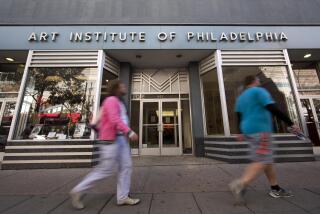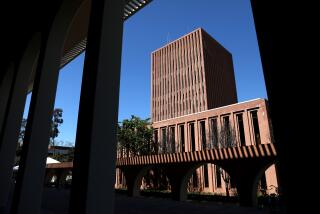2 Years of Problems Pushed United Education Into Reorganization
- Share via
Nora Lee began to worry about her job a few weeks ago. Until Friday, she was the director of financial aid at Pacific Coast Technical Institute in Oakland, a trade school owned by Encino-based United Education & Software. But she noticed that over the past month the parent company hadn’t been paying any of the school’s bills--except for the utility bills.
Lee said she sensed something was going on, and rumors spread that UES was planning to file for bankruptcy. The week after Thanksgiving, school officials were told by UES that the Oakland school was up for sale, though no explanation was given. That Friday, employees received cashier’s checks instead of standard payroll checks. A note enclosed with each check said the checks were different because the company was merely changing banks.
Then early last week, a corporate executive told school employees that as of last Friday, they were all to take unpaid leaves of absence. Employees pressed the executive, saying they had heard the company had filed for bankruptcy. “He stuttered and made a phone call,” Lee recalled. “He returned and confirmed we had filed Chapter 11 and said Friday was our last day.”
Such is the fall of a once-thriving company.
Last week, Aaron Cohen, UES president and chief executive, announced that UES’ chief operating subsidiary that owns 25 of its 26 trade schools had filed for Chapter 11 bankruptcy protection with the federal bankruptcy court in Los Angeles.
“It screams to me of mismanagement,” Lee said.
It wasn’t that long ago that UES was on the rise. In the fiscal year that ended Jan. 31, 1988, United Education’s earnings nearly tripled to $4.4 million while sales more than doubled to $70 million. The company’s stock kept climbing. It soared 142% in 1987--making it the top gainer among Valley companies--and it hit a high of $16.38 a share in March, 1988, adjusted for a 3-for-2 stock split.
But since then, United has suffered a series of devastating problems. The federal government uncovered widespread incompetence at UES’ student loan processing subsidiary, including failing to notify delinquent borrowers. UES sold off that troubled business, but the company found itself named in lawsuits involving possible debts of $650 million.
Then in October of this year, the state moved to stop guaranteeing student loans at one of UES’ trade schools because a federal audit found that courses were too short to meet minimum federal standards, students were misled regarding costs, and students who were academically unprepared were admitted. And last month, a $24-million consumer protection complaint was filed against the company by California Atty. Gen. John Van de Kamp, alleging that one of UES’ schools provided shoddy education.
A spokesman said the company did not have sufficient cash flow to keep its schools operating. UES said it plans to sell or close 12 of its 26 schools, or merge them with remaining schools. “It will be a downsized operation,” said C. Ronald Kimberling, UES senior vice president. “The schools that will remain will tend to be more profitable institutions.”
In the bankruptcy filing, UES said its assets totaled $71.9 million as of Sept. 30, and liabilities totaled $51.7 million.
The company, which reported a $5-million loss on $17.5 million in revenue in the fiscal second quarter that ended July 31, saw its stock fall to 19 cents as of Friday’s close.
The Chapter 11 filing means UES will receive some protection from its creditors and from lawsuits against the company, and its business dealings will fall under the jurisdiction of the bankruptcy court. Unlike a Chapter 7 bankruptcy, which is essentially a liquidation, the intent of Chapter 11 is for a company to reorganize. That means UES must come to terms with Security Pacific National Bank and Union Bank--whose loans to UES are secured by the company’s assets--as well as its unsecured creditors, to whom UES owes $21 million. Neither bank would comment on UES’ bankruptcy filing.
But it might not be easy for UES to get out of bankruptcy court. Jerry Smilowitz, California deputy attorney general, said the state plans to press its $24-million suit against UES, which contends that UES’ National Technical Schools home-study computer program, among other things, misled students into thinking they would qualify for computer jobs when they graduated and failed to properly refund loan money after students dropped out. UES has denied the charges.
Smilowitz said the state might try to win a court injunction against UES to prevent it from failing to inform students of the dropout rates of its schools or to force the company to make changes in some of its courses. Although the state’s intention is not to shut down the company, Smilowitz said, “there is the possibility that if we get a very restrictive injunction, that could be a killer.”
Jeffrey Kessler, an analyst at Shearson Lehman Hutton, said UES has some valuable assets, although he said he couldn’t estimate the breakup value of those assets. Kessler said a scaled-down version of UES could survive.
But some observers wonder if UES can continue to operate, even in a smaller form. “I’ve got out my rosary,” said Rex Sinquefield, chief investment officer of Dimensional Fund Advisors in Santa Monica, one of UES’ largest shareholders. In the meantime, Sinquefield said, “there isn’t much of a market for bankrupt stock.” If an institutional shareholder did try to sell, he said, “they would probably get out at a penny a share.”
Matt Dickstein, a spokesman for AIFS Inc., a San Francisco education services company that owns 5% of UES stock and previously said it might attempt a takeover of UES, said, “It certainly hasn’t been a very good investment for us.” Asked whether a buyout was still contemplated, Dickstein said, “I can’t come up with too many scenarios where that makes sense.”
Among the lawsuits UES faces are several from shareholders. In May, 1988, a UES stock offering raised nearly $17 million. Investors allege that UES officials made false and misleading statements to inflate the price of the stock.
Former employees say UES brought about its own downfall. John Kleinhans, an instructor at National Technical Schools in Los Angeles, said the bankruptcy filing did not surprise him. Kleinhans described the management of National Technical Schools as a “free-for-all” in which employees were given no guidelines or procedures. “We didn’t have towels for weeks in the bathrooms. For a very long time I could see the trend,” he said.
The first inkling of trouble was in April, 1988, when the California Student Aid Commission, a state agency that administers the federal student loan guarantee program, said it was investigating several UES schools because of concerns over high default rates and problems with tuition refunds after students dropped out.
Shortly afterward, a federal probe found major operational problems at UES’ student loan processing subsidiary. UES has been sued by shareholders over the loan foul-up, and it was also named as a third-party defendant by Peat, Marwick Main & Co., its former auditor, in suits filed by banks that backed the loans. The banks stand to lose up to $650 million because the government will not pay for loans that go into default.
UES was still recovering from the loan incident--it lost $14 million in the fiscal year that ended Jan. 31, 1989, on $81 million in revenue--when an audit by the U.S. Department of Education, released in September, uncovered widespread problems at National Technical Schools.
As a result of the audit, the California Student Aid Commission said National Technical Schools should be banned from the federal loan program. UES stopped accepting new students at the school last month and laid off 170 of the school’s 196 workers.
UES blamed its need to file for bankruptcy protection on the student aid commission, saying the commission’s actions resulted in lenders refusing to approve loans to students of National Technical Schools, effectively shutting the school and creating a cash crunch at the company.
Lee has since taken a job as a financial aid administrator for another trade school in the Bay area. But it does not make her feel better about her six months at UES.
“We were providing the education for these inner-city people, for them to have a chance in life. But because somebody screwed up administratively” at United Education, she said, the students “are not going to get an education. That’s what angers me.”
UNITED EDUCATION & SOFTWARE’S RISE AND FALL Two years ago United Education & Software, an operator of trade schools, was on the fast track. Its earnings kept growing and its stock kept soaring. But last week UES filed for Chapter 11 bankruptcy protection from its creditors. The Encino company’s problems began last year when a federal probe uncovered numerous problems at its former student loan processing subsidiary. Listed below are some major events leading up to UES’ bankruptcy filing.
March, 1988: UES’ stock hits an all-time high of $16.38. UES also reports record sales and profits for its fiscal year, as earnings more than double to $4.4 million.
April, 1988: The California Student Aid Commission says it is investigating student aid programs at several of UES’ schools. UES’ stock sinks to $12.63 the day after the probe is disclosed.
August, 1988: A Barron’s article reveals that government and private auditors have found inadequate student loan records at UES’ student loan servicing subsidiary. The stock falls to $4.13 a share.
November, 1988: UES says it will sell its student loan processing unit to Bank of America and will take a $9.5 million writedown.
February, 1989: UES hires some former government officials to try and restore its reputation. Newcomers include C. Ronald Kimberling, former assistant secretary for the U.S. Dept. of Education, and Richard P. Reinhardt, former deputy director of the California Student Aid Commission.
May, 1989: UES reports a $14.3 million loss for its Jan. 31, 1989 fiscal year.
August, 1989: Peat, Marwick Main & Co., UES’ former auditor, files a court complaint against UES over the student loan problems. Peat Marwick was named as a third-party defendent by Bank of America, which was trustee for the student loans and says it stands to lose up to $650 million because of UES’ loan foul-ups. UES’ stock is worth about $2.
October, 1989: The California Student Aid Commission says it will no longer guarantee student loans taken out by students at one of UES’ trade schools because a U.S. Dept. of Education audit found the school didn’t meet federal standards.
November, 1989: Calif. Atty. Gen. John Van de Kamp sues UES for $24 million alleging one of UES’ schools misled students and provided shoddy education.
December, 1989: UES files for Chapter 11 bankruptcy protection. Its stock falls to 19 cents a share. / Los Angeles Times
More to Read
Sign up for Essential California
The most important California stories and recommendations in your inbox every morning.
You may occasionally receive promotional content from the Los Angeles Times.














